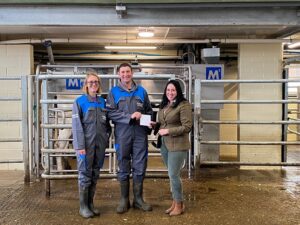 Farmers are turning to the Internet of Things (IoT) to help them manage their livestock more effectively, boosting productivity and animal health.
Farmers are turning to the Internet of Things (IoT) to help them manage their livestock more effectively, boosting productivity and animal health.
A new project, which should be available on farms within the next three years, is bringing together the latest technology to remotely weigh and record data on cattle. “Farm businesses are under intense pressure, and by using the IoT they can gather information regularly and review it quickly to help them make informed decisions,” explains Keith Evans, technical lead at PrognostiX, which is developing the technology. “Through this new project they will be able to reap the benefits of precision farming and real-time monitoring of livestock.”
Smart agriculture is becoming more common, but in order to accelerate the worldwide adoption of IoT, farmers and need low cost, low-power sensors – and that’s where LoRa technology comes into play. “It’s very exciting – we’re taking technology developed for other industries and adapting it specifically for agriculture to deliver real benefits at significantly lower cost – so it will be accessible to all,” says Mr Evans.
Working with Nottingham University and British Telecom, the PrognostiX team expects the smart solution, named Y-Ware, to have far-reaching benefits for the industry – from practical farm improvements to retailer traceability.
The system runs from a small sensor located in the animal’s rumen, where it remains without harm to the cow. This constantly measures the animal’s temperature and is linked via long-distance LoRa wireless technology to an Edge hub, which records all the data in one place. When combined with a wireless weighing platform, it can send alerts to the farmer when an animal isn’t gaining weight or has a temperature, enabling them to act swiftly, improving recovery speeds and reducing the use of antibiotics.
“Using wireless RF technology and the LoRa protocol is ideal for sensors that only need to update information a few times per hour,” explains Mr Evans. “This saves on power consumption and subsequently extends battery lifespan.”
The project secured funding through Innovate UK – and at £1.13m over three years is one of the biggest grants awarded through the scheme. “IoT is set to push the future of agribusiness to the next level,” he adds. “By leveraging LoRa technology and the LoRa WAN open protocol, agribusinesses can digitally monitor, manage and analyse every aspect of their business, improving their overall operations and return on investment.”
Since many farms are in rural areas without access to cellular or licensed spectrum coverage they need an easy to install network infrastructure for their IoT applications – something which PrognostiX can offer through its Rapid Site 4G coverage in conjunction with EE.
“The future of farming is one of real-time data monitoring, sensing solutions and long-term data analysis, in conjunction with detailed dashboard visualisation and sophisticated data analytics,” explains Mr Evans. “LoRa-enabled devices can manage a multitude of situations in smart agriculture, ranging from temperature-sensing devices in a herd of cattle out at grass, to monitoring soil moisture and grass growth.”
The Y-Ware project will be at the forefront of the application and deployment of LoRa technology within the livestock sector. “In future it will become extremely valuable to agribusinesses as they adapt to the changing demands of the agriculture industry. This really is game changing technology.”



